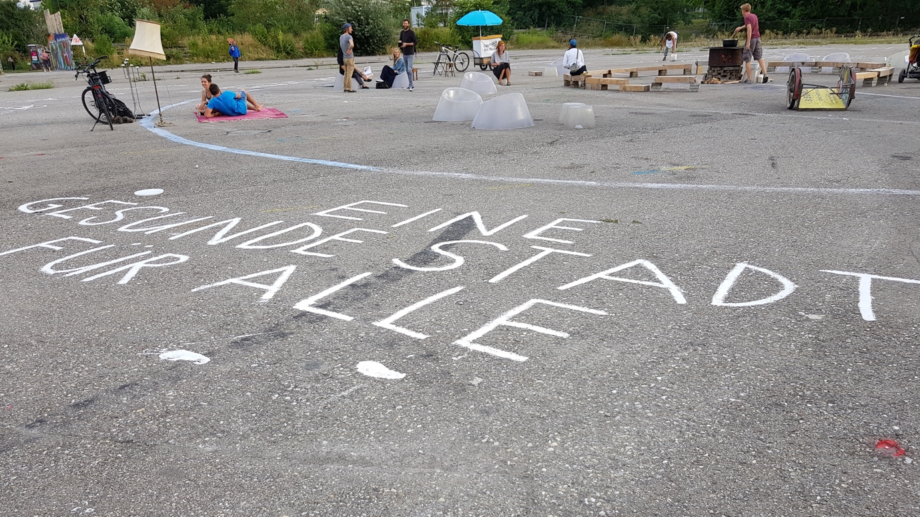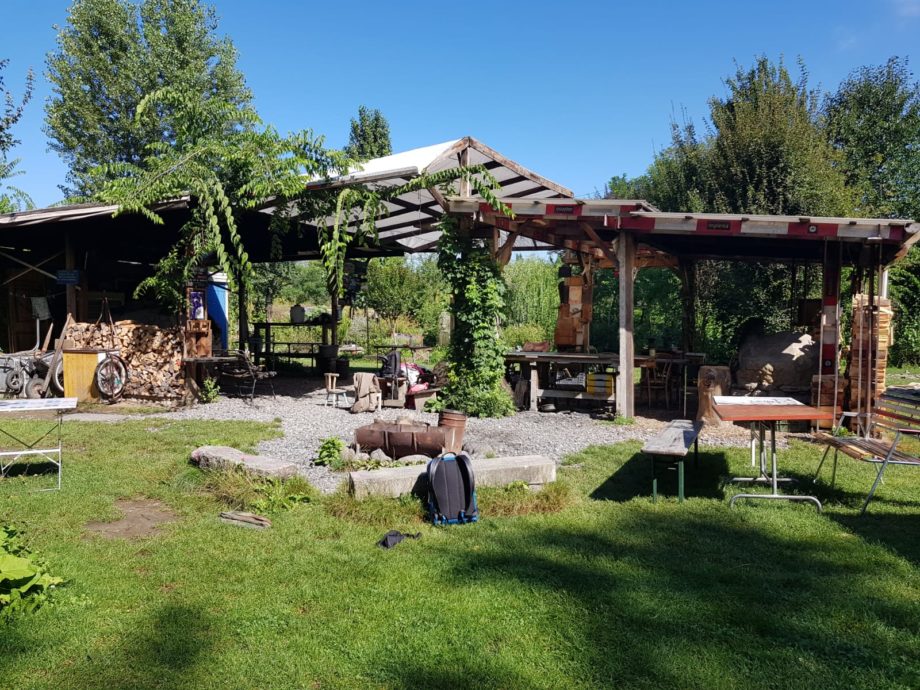The promise of (fieldwork) planning
“I asked one of the constructors’ representatives, ‘Do you really believe it’s going to get built?’. I just wanted to hear him say it. At one of their events. And then, no hesitation, he said: ‘Of course. The only thing that could stop us now is a property market crisis.’ And then he laughed. Can you believe it? To say such a thing, now? It’s a classic high-risk plan. A typical high-risk man project, and I’m so tired of that.”
I sit with Lea*, a local organiser at the end of an interview over lunch in a neat municipal park, and we linger in silence for a few beats. She recoils a little after having uttered these last words, much less diplomatically tentative than the bulk of our conversation; she rests her head on her left hand, burying a cheek in her palm, her glance lowered towards the edge of the picnic table. With her other hand, she pokes in a half-empty takeout box with a fork. Her statement refers to a private-public urban development plan she’s been opposing, but I flinch at how aptly her words could just as well describe my intended PhD fieldwork plan – to start in April 2020 in Palestine, indefinitely postponed. Notably not due to a property market crisis, but one that maybe was in other ways bound to come. My pre-pandemic plan was to investigate the ways in which the largest privately planned urban development project in the Occupied West Bank shaped and was shaped by gender relations. While reconsidering the scale and scope of my research practice over the past months, I have started looking into the gendered politics of and resistances to urban transformation in Zurich, the city I found myself in at the time of the SARS-CoV-2 outbreak.
Through her longstanding involvement in a neighbourhood association and her commitment to feminist organising, Lea has been advocating against the for-profit transformation of Zurich West, the city’s post-industrial area with a perennial narrative of “up-and-coming”-ness, while repeatedly witnessing the overruling of collective struggles for communal access to (green) city space in favour of public-private ‘revitalisation’. The development project Lea denounces as a “high risk ‘man project’” concerns one of the largest land reserves in Zurich, a city in which yet to be developed plots are among the scarcest in Switzerland (ARE 2017). The area at stake is an old football stadium plot on which a communally developed space has emerged since the stadium’s dismantlement in 2007, as an interim usage in accord with the municipality. On the day I meet with Lea, it is only a few days until the citizens of Zurich eligible to vote will decide on its future.
With a ‘yes’ majority in the communal vote, the area will be turned into a new privately-funded neighbourhood including two luxury high-rises, a small parcel of cooperative housing, and a football stadium sponsored by one of the top Swiss banks. If voters however cast a ‘no’ ballot, the 55000 m2 plot would remain in its current state: a dense multi-purpose area including a park, a day-care, gardening patches, sports infrastructure, a communal kitchen and a cemented square for flexible event use, at least until a new plan is negotiated. A number of local associations, loosely organised feminist and climate activist groups as well as neighbours who have been caring for, experimenting in and maintaining this space over the last decade, have been engaged in the struggle against the development project for years, mostly through articulations of right to the city activism and the concerted invocation of direct democratic rights.

Image 1: The old football field, now cemented, during a communal event in August 2020. Visitors were invited to articulate their vision for the space in white paint on cement; someone imagined “eine gesunde Stadt für alle”, a healthy city for all. (Photo: courtesy of the author).
The fragile frustration shown by my interlocutor can be read as one profusely shaped by the unbridled material transformation of a known and trusted space; a response not necessarily frightened by the breakneck speed of capital flows that gnaw at imaginaries of home and belonging, but aware of their insidious efficacy. Lea’s utterance requires contextualisation that exceeds this piece’s scope, as it breaks down the impending situation to a perilous essentialisation along gender binaries, simply ligating a propensity for risk-taking to maleness; but it also speaks to her embodied perceptions of time and futurity, as well as her political imperative to protect feminist egalitarian spaces; it is the impulsive statement of a politically active subject reaching an emotional limit, however one that evokes complex reflections on the patriarchal history of (urban) planning (e.g. van den Berg 2018), gendered impacts of the financialisation of cityscapes (e.g. Pollard 2012) and feminist theories of becoming, of the otherwise, of a city’s undecidability (Kern & McLean 2017).
The bottom-up, slow growth of undefined spaces such as the communal plot on the old stadium area lends to urban space the elasticity capable of accommodating uncertainty and crisis, conditions which have very sturdily become omnipresent narratives (Roitman 2014) of the Capitalocene rather than sudden exceptions. In the wake of the global spread of SARS-CoV-2, these undetermined spaces might regain centrality in urban conglomerates as playgrounds – or battlefields – of the possible. From a feminist urbanist perspective, such as the one adopted by Leslie Kern & Heather McLean, these undecidable spaces offer the possibility of “something (resistance, solidarity, survival) to emerge” (2017: 407). Indeed, the affirmative teleology of Kern & McLean’s theoretical intervention is met by a polyphony of current calls for a total rethinking of ‘what we want the city of the future to be’ in the light of the pandemic (radical calls that rarely do, however, perturb the neoliberal logic of urban lives, as seen in ongoing privatisation and uninterrupted eviction patterns in many parts of the world).

Image 2: A communally built kitchen lies at what its users call ‘the heart’ of the area. (Photo: Courtesy of the author).
Much like the social and material infrastructure of cities worldwide, ethnographic research was largely brought to sudden shock by the SARS-CoV-2 crisis. With many a field physically inaccessible, calls for digital ethnography, remote elicitation methods or wearable tech as a possible data collecting tool suddenly abounded. While these methods may very well have been of considerable use to certain interrupted projects, they were cosmetic at best for others, especially those of ethnographers who were about to initially access their fields, or those whose newly configured care geographies made smooth sailing impossible even for desk or digital work.
In the spring of 2020, the cynicism of universities’ ‘business as usual’ strategies seemed to have permeated any and all disciplines. The eagerness to keep the ball rolling, even in anthropology, reminded me of the lengths gone to grant linearity in the performative “tactics, technologies and institutions” (Abram 2013: 11) of urban planning; selling dreams of progress through concrete growth even in a state of global turmoil. As an exercise to think through this parallel, I dislodge Lea’s statement from the context of citizen struggle against privatised urban planning, and reposit it on the strenuous ground of planning my own doctoral fieldwork during the pandemic. “A classic high-risk project” – would that moniker also apply to my own originally intended fieldwork in an emerging billion-dollar planned town in Palestine? A research project contingent on so many variables, including the now so globally strained categories of mobility and health; variables obfuscated in front of selection committees by my own supposedly “trusted” positionality as a young, hypermobile, white and cis-gendered academic?
Tracing back my process of application to PhD funding in 2018-19, I am reminded of numerous four-year milestone tables, career plans and neat research designs. The linear futurity I had to be able to present in order to succeed, echoed the rhetorical and/or visual “promise of the future” (Abram 2013) often observed in the neoliberal urban planning my interlocutors in Zurich oppose; a practice that produces mechanisms that “conjure worlds that are within its scope of action” (Abram & Weszkalnys 2011: 10), rather than providing accurate descriptions of current power imbalances or incumbent complexities. More and more convinced that my envisioned feminist research practice was irreconcilable with these structures, I begin to ask: In what ways are the optimistic tactics adopted to obtain funding based on affective speculation, much like the glossy architectural renderings prophesying the urban materialisation of a ‘good life’ in my intended Palestinian field, or my currently accessed Swiss field? And when these prophesies are undone by external circumstances, can the indispensable openness of anthropological research as an inductive practice of inevitable detours survive the corporatisation of academic institutions and funding opportunities?
The current moment gives us doctoral students located and locked at the beginning of ethnographic projects an opportunity to dwell on these questions, by taking the impasse seriously and considering its methodological potentials while pressing pause. Such a refusal of following planned paths, as medical anthropologist Aidan Seale-Feldman recently said, could allow us to «think with the limitations of the virus and participate in collaborative, engaged, and activist work that contributes to collective projects of liberation and well-being» (Summers 2020). For instance, by drawing from decolonial and feminist research praxis in challenging the smooth continuity of fieldwork through “patchwork ethnography” (Günel, Varma & Watanabe 2020); or by ultimately and permanently blurring the dichotomy between field and home, and exploring the political potential of such a blurring (Schwaller, Perl & Kehr 2020). Possibly, in this yet to be defined pandemic time-space, we can find a way to conceptualise ethnography by thinking our fields of study through the metaphor of the old stadium plot: by refusing the smooth surface of a promised future, and rediscover the field as a “differential commons” (Noterman 2015), a slowly-densifying, generative spacing of multiple purposes, needs and outcomes.
*All names used are pseudonyms.
Written on 5 October 2020.
Sabrina Stallone is a doctoral researcher in social anthropology at the University of Bern. Her research is broadly concerned with urban politics and gendered subjectivities, and it has so far taken her to cities in Palestine, Israel, Italy and Switzerland.
References
ARE. 2017. «Bauzonenstatistik Schweiz 2017 – Statistik und Analysen.» Bundesamt für Raumentwicklung, Bern. URL: https://www.are.admin.ch/dam/are/de/dokumente/
grundlagen/dokumente/bauzonenstatistik-schweiz-2017-statistik-und-analysen.pdf.download.pdf/Bauzonenstatistik_Schweiz_2017.pdf.
Abram, Simone and Gisa Weszkalnys. 2011. ”Introduction: Anthropologies of planning— Temporality, imagination, and ethnography.” Focaal—Journal of Global and Historical Anthropology 61: 3–18.
Abram, Simone. 2013. “The future of planning?“ Metropolitics, 13 November. http://en.metropolitiques.eu/spip.php?article583.
van den Berg, Marguerite. 2018. “The Discursive Uses of Jane Jacobs for the Genderfying City: Understanding the Productions of Space for Post-Fordist Gender Notions.” Urban Studies 55 (4): 751–66.
Günel, Gökçe, Saiba Varma, and Chika Watanabe. 2020. “A Manifesto for Patchwork Ethnography.” Member Voices, Fieldsights, June 9. https://culanth.org/fieldsights/a-manifesto-for-patchwork-ethnography
Kern, Leslie, and Heather McLean. 2017. “Undecidability and the Urban: Feminist Pathways through Urban Political Economy.” ACME 16 (3): 405–26.
Noterman, Elsa. 2015. «Beyond Tragedy: Differential Commoning in a Manufactured Housing Cooperative.” Antipode, 48: 433– 452.
Roitman Janet. 2014. Anti-Crisis. Durham, London: Duke University Press.
Pollard, Lisa. 2012. “Gendering capital: Financial crisis, financialization and (an agendafor) economic geography.” Progress in Human Geography 37(3): 403–423.
Schwaller, Corinne, Gerhild Perl, and Janina Kehr. 2020. “Valuation Struggles: Rethinking the Economy in Times of Crisis: A Conversation With Susana Narotzky, Patrícia Matos and Antonio Maria Pusceddu”. TSANTSA – Journal of the Swiss Anthropological Association 25 (September): 175-86.
Summers, Lachlan. 2020. “A Sudden Shock of Care: An Interview with Aidan Seale-Feldman.” Supplementals, Fieldsights, August 18. https://culanth.org/fieldsights/a-sudden-shock-of-care-an-interview-with-aidan-seale-feldman































